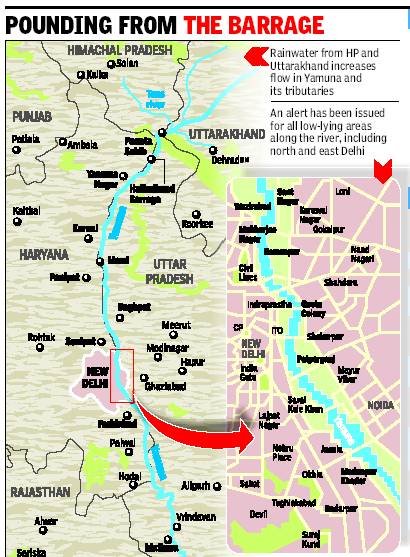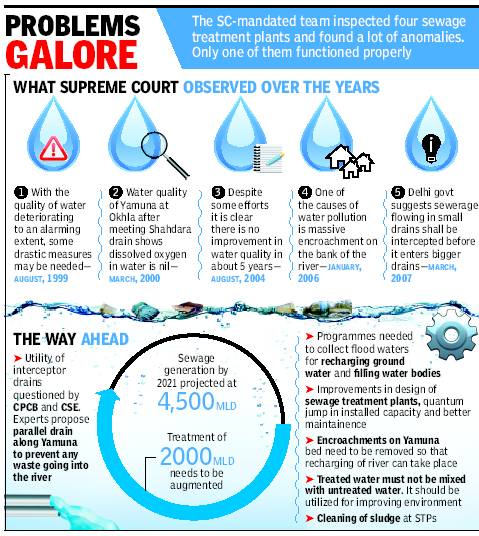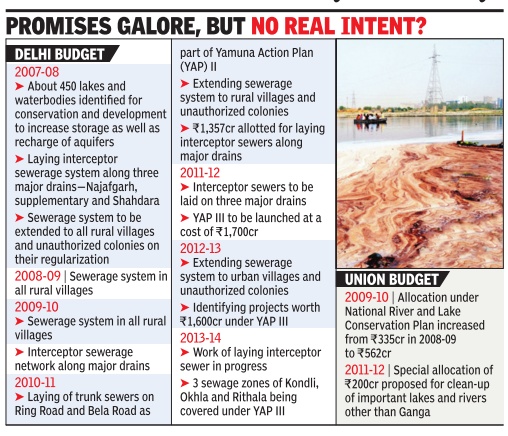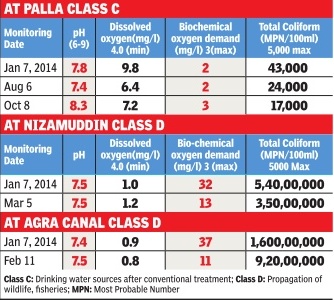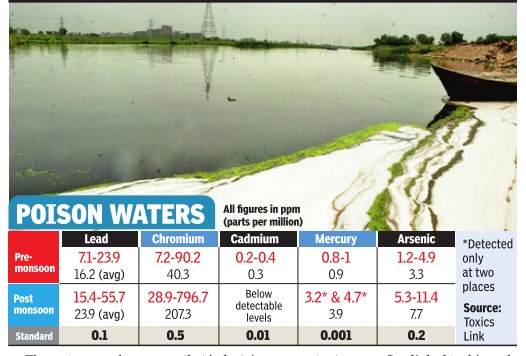River Yamuna
This is a collection of newspaper articles selected for the excellence of their content. |
Contents |
Yamuna: The state of the river/ Pollution
Why the Yamuna is dead
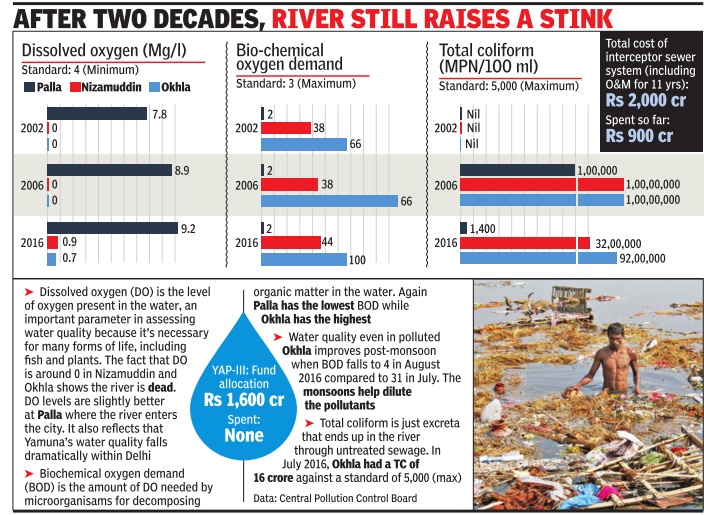
The city has spent over Rs 2,000 crore on Yamuna clean-up in the last 22 years.This shocking revelation came during a hearing in the Supreme Court. The reality becomes starker when you consider recent and past data that show no improvement in water quality: total coliform, or mostly human and animal excreta, continues to be in lakhs, and even crores, when the standard is a maximum of 5,000 mpn100 ml (most probably number100 ml). Also, dissolved oxygen (DO), a must for many forms of life in the water, continues to be negligible, which reiterates that it's a dead river. DO levels in March months of 2002 and 2006 at Nizamuddin and Palla were 0; in 2016, these were 0.9 and 0.7, respectively .Total coliform levels went up to 16 crore in June last year. No Yamuna cleaning project has managed to bring a perceptible difference to water quality .Apart from Yamuna Action Plans on which the bulk of funds were spent, the National Green Tribunal, in its 2015 judgment, had ordered augmenting the functioning of sewage-treatment plants that are running under capacity and constructing 32 smaller STPs in a decentralised manner.
“According to DJB, there are 23 STP's planned and existing as of today in Delhi....the oxidation pond at Timarpur, which was commissioned in 1947, is proposed to be closed.There is an STP at Okhla, which was commissioned in 1937, and four STP's at Kondli are lying closed due to inadequate sewerage...the entire STP infrastructure, if made fully functional, can be utilised to support and aid implementation of the project,“ NGT had said. There is no implementation of this order so far. Delhi Jal Board claims that it has the capacity to treat 604 million gallons per day of sewage, of which it is treating about 75%.
Brij Gopal, former JNU professor and member of NGT's expert panel on Yamuna, said: “Nothing has moved.Sewage is not even reaching the STPs. If untreated sewage is flowing down the drain, what do you expect? Plus there is no flow in the river.“
Under phases I and II of the Yamuna Action Plan, launched in 1993, Rs 576.73 crore has already been spent. Under YAP-III, an additional Rs 1,600 crore has been allocated, which is yet to be used.
“Yamuna, like all of Delhi, has suffered due to multiplicity of agencies. Crores were definitely allocated but the money was used incoherently . DJB was doing something while the corporations were doing something else. We are hopeful now that the interceptor sewer system, when it is completed by next year, will finally clean the river,“ said a senior government official.
Experts also say that policies to clean Yamuna have only been STP-oriented when the biggest issue is the fact that the river has no water or ecological flow. SC, in a 1998 order, had directed that 10 cumecs of water be released into the river through the year. Experts feel that 10 cumecs is inadequate, but as of now even that is not being released. Following NGT's 2015 judgment, about 10 cumecs is being released at Hatnikund, but that reduces significantly as it flows downstream. “The only answer to this is to ensure more water is released. Sewage treatment alone cannot ensure unhindered flow“ said Manoj Mishra of Yamuna Jiye Abhiyan, who had moved NGT on Yamuna pollution.
Meanwhile both Centre and Delhi government have an nounced several cosmetic measures. For example, last year, Centre launched a trash skimmer to clean the water surface and announced a “proper“ chhat ghat. In an effort to develop the river front, Delhi government started a Yamuna Aarti and developed a `Nakshatra Vatika' along the river bed.
Union water minister Uma Bharti had announced last year that Lakhwar Vyasi Dam in Uttarakhand would release water in Yamuna during lean season, which was contested by environmental experts because the project is unlikely to get environmental clearance.
2010-17: Oxygen levels show why Yamuna is practically dead
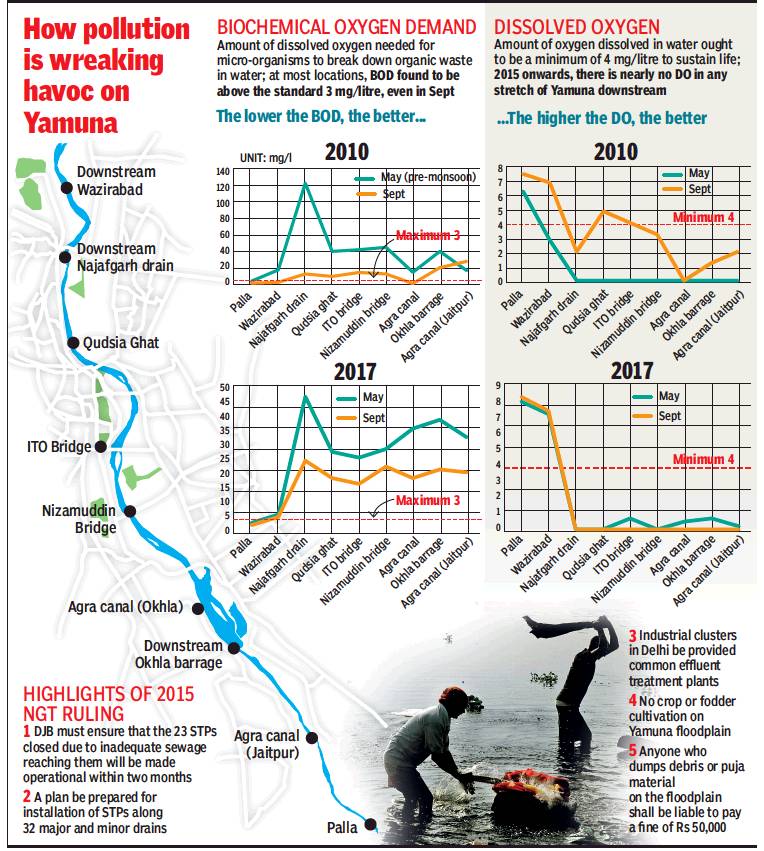
From: Jayashree Nandi, Oxygen levels show why Yamuna is dead for all practical purposes, August 27, 2018: The Times of India
Intensity Of Pollution Has Risen In Last 5 Years Or So
Despite several SC and NGT orders, almost the entire stretch of Yamuna in Delhi continues to be severely polluted. In fact, the intensity of pollution may have increased in the last 4-5 years, an analysis of the Delhi Pollution Control Committee’s Yamuna water quality data has revealed.
For example, dissolved oxygen (DO) levels — the amount of oxygen dissolved in water — ought to be a minimum of 4 mg/litre, but 2015 onwards, there is nearly no DO in any stretch of Yamuna downstream, even in September (post-monsoon).
The pre-monsoon data of May from 2010 to 2018 also shows DO levels to be nil everywhere except in Palla and Surghat (downstream of Wazirabad barrage) where Yamuna enters the city. DPCC’s data reveals that while pollution levels haven’t improved, they may have actually deteriorated further in most stretches as the inflow of sewage increased over the years.
Now, all eyes are on two interventions — implementation of National Green Tribunal’s “Mailey se Nirmal Yamuna” and laying of interceptor sewage lines along Delhi’s three biggest drains, likely to be completed by January 2019.
Recently, Delhi Jal Board had submitted its draft report on sewerage management and performance of sewage treatment plants to NGT, which revealed that, at most places, the biochemical oxygen demand (BOD) — the amount of dissolved oxygen needed for micro-organisms to breakdown the organic waste in water or, in simple terms, oxygen needed by the river to sustain life — did not meet the standard (it should not exceed 3mg/litre).
In lay man terms, the lower the BOD, the better it is for river life. On the other hand, the higher the DO, the better it is.
Most STPs are either closed or working way below capacity. Out of a total of 607.06 million gallons per day of operational capacity, only 476.74 MGD sewage is treated. “We have already recorded a clear finding of the failure of the administration in handling the situation and repeated failure in carrying out binding directions in various orders,” a bench headed by chairperson Adarsh Kumar Goel said recently while evaluating the implementation of NGT’s January 2015 order on a decentralised sewerage system where sewage falling into all drains is tapped and treated.
NGT constituted a committee that will monitor compliance with the order on a day-to-day basis. The committee comprising Shailaja Chandra, former chief secretary, Delhi, and BS Sajwan, former principal chief conservator of forests, will take stock of all action taken so far to comply with the January 2019 order.
The mandate of the committee will be to ensure safe standard of water quality at the entry and exit points of Yamuna in the long run. The committee may also consider approving collection of funds for the project by applying the “polluter pays” principle, the NGT order said.
They will also conduct regular inspections and analyse pollution levels with assistance from CPCB. “We are hopeful that this monitoring committee will ensure implementation of NGT’s Yamuna order because the committee members are retired and not working in their official capacity unlike the previous committee. NGT has also said that this committee will monitor implementation on a day-to-day basis. As far as DPCC’s data is concerned, it’s no surprise that even in September, DO is nil. It shows that intensity of pollution and sewage entering the river has increased. Yamuna, downstream of Wazirabad is all sewage except during monsoon,” Manoj Mishra of Yamuna Jiye Abhiyan said.
2011: assessment of water quality
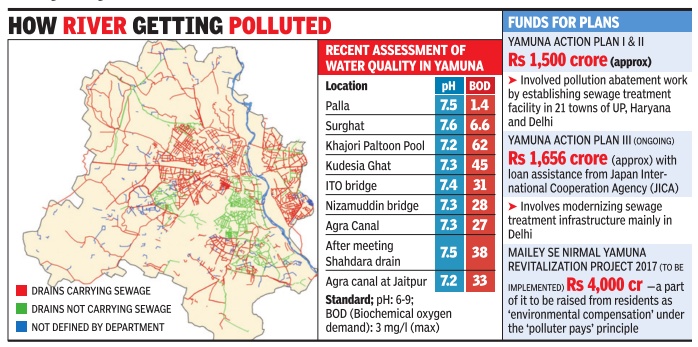
6,500cr and 19yrs later, Yamuna dirtier than ever/ Clean-Up Plan Flops, SC Review today
By Neha Lalchandani 2013/03/11
[In 1994?] the Supreme Court first scrutinized pollution in the Yamuna. Innumerable orders later, Yamuna is dirtier than ever with a mind-numbing Rs 6,500 crore spent to clean the river and the latest plan — interceptor sewers — going
When SC reviews Yamuna’s pollution, it could be back to the drawing board. Six years after the Delhi Jal Board proposed interceptor sewers to treat sewage before it flows into major drains, just Rs 51 crore of the Rs 1,963 crore scheme has been spent.
Worse, it is not even clear if the measure that was to improve water quality by 2010 will actually work in light of the rapid growth of unauthorized colonies discharging sewage into the river, an issue flagged even in 2007 by an official committee that approved the interceptor proposal.
The committee had warned that 1,432 unauthorized colonies were the nub of the problem. By 2012, their number had jumped to 1,639. Although these colonies have been promised regularization, drainage and sewers are years away. In 2007, 517 of 567 unauthorized regularized colonies had sewers. The number grew by just six in the next five years. DJB says it is tough to provide sewerage in such densely populated colonies where they have barely any road space for their work.
A report submitted to the court by an inspection team that included amicus curiae Ranjit Kumar as recently as November last year called for sewage connections to all new colonies, whether authorized or not.
It pointed out that Delhi’s 17 sewage treatment plants (STPs) have a capacity of 2,460 MGD against utilization of 1,558 MGD. Delhi’s sewage generation is around 3,800 MGD.
Throwing money in the river
6,500cr spent by Delhi, UP and Haryana to clean Yamuna. This includes central funds. No improvement in water quality in past 8 yrs Only 51cr of 1,963cr sanctioned for interceptor drains spent. Scheme proposed in 2007, was to deliver results by 2010 Number of unauthorized colonies has jumped from 1,432 in 2007 to 1,639 in 2012
Only 55% of Delhi’s population served by sewer system
Delhi’s installed sewage treatment capacity is 2,460 MLD. Sewage generated is 3,800 MLD. But just 63% of installed capacity is being used
City’s biggest drain, Najafgarh, discharges 2,064 MLD. Only 30% is treated.
Worse, treated sewage is again mixed with waste
SC-mandated team inspected 4 sewage treatment plants in November 2012.
All four were deficient
Heavy metals in city’s drinking water
Delhi’s drinking water is contaminated with tonnes of industrial waste. Industries located upstream of the Yamuna have been found to be discharging untreated waste into the river, leading to the presence of heavy metals in water that is picked up at Wazirabad to meet the city’s drinking water needs.
Manoj Misra of the Yamuna Jiye Abhiyan had water from the Dhanura Escape — a channel that empties into the Yamuna — tested at a laboratory in Gwalior and found that the levels of chromium, lead and iron were higher than permissible. “While chromium was 0.13 mg/l against 0.05 mg/l, lead was 0.035 mg/l against 0.01mg/l and iron was 3.51mg/l against a permissible 0.1 mg/l. The presence of heavy metals is even more problematic since the treatment plants in Delhi are not equipped to detect or treat them,” said Misra.
Pollution from industries in Haryana, especially those located in and around Panipat and Sonepat, has caused treatment plants to stop functioning on several occasions after ammonia level went so high that it could not be treated. Untreated industrial effluent from Yamuna Nagar, Misra said, is released into the Dhanura Escape from where it meets the river upstream of Kunjpura in the Karnal district.
“Similarly, toxic waste from Panipat falls into the Yamuna near the village of Simla Gujran in Panipat district. Samples from the Dhanura Escape show presence of heavy metals, known health hazards and a clear indication of industrial pollution. This water is picked up at Wazirabad for treatment at Chandrawal and Wazirabad treatment plants,” he said.
Other than heavy metals, other pollutants, too, were much higher than BIS norms for drinking water. Total coliform was 1,200 against the permissible limit of 10, total dissolved solids were 3,324 against the permissible limit of 500, biochemical oxygen demand was 240 mg/l against a limit of 30 mg/l, and chemical oxygen demand was 768 mg/l against a limit of 250 mg/l, Misra added.
Central Pollution Control Board officials said they had made it compulsory for all industries to have effluent treatment plants. “Most industries have installed ETPs but either the treatment is not up to mark or not all effluent is reaching the ETPs. We have set up a real time water pollution monitoring station at Wazirabad where we monitor 10 parameters... heavy metals are not monitored as they cannot be treated in the plants,” said an official.
The wish list
Haryana government release more water from Hathnikund Barrage for Uttar Pradesh
Alternate arrangement be made for disposal of untreated sewage in Delhi, which is at present dumped into the river at 22 places
The holy river be given due respect
The water has not improved despite generous funds
WATER QUALITY WORSE - Funds flow, Yamuna stays filthy
Jayashree.Nandi@timesgroup.com New Delhi
The Times of India Jul 15 2014
Every year the state and union budgets raise hopes that the Yamuna may after all soon get a new lease of life. In fact, the Delhi government's budget has been making the exact same promise for seven years (2008-14). Providing sewerage in urban villages and unauthorized colonies and laying interceptor sewers along major drains is its solution for Yamuna's pollution crisis. It has allotted over Rs 3,500 crore for these projects--mostly under the Yamuna Action Plans--to complete the work and ensure “discharge of pollutants comes down considerably“.
But 2014 Yamuna water sample investigations by Central Pollution Control Board (CPCB) show levels have not improved; they are worse at some sites. Delhi Pollution Control Committee (DPCC) officials also confirmed to TOI that water quality parameters including biological oxygen demand (BOD) and total coliform levels have only deteriorated or are the same in almost all monitoring sites.
Interestingly , Delhi Jal Board (DJB) claims that 68% of the work of laying the interceptor sewer--large sewer lines that control the flow of sewage to a treatment plant--is already done. The project is divided into packages, out of which two will be completed by the end of 2014 and the rest by 2015. It also claims that of 2,574 urban and rural villages, unauthorized colonies and other un-sewered colonies, sewerage was provided in 842.
But no one seems to be sure why water quality hasn't started improving. One of the reasons, say officials, is that these projects will work only when sewage treatment plants func tion to their full capacity. As of now, most STPs are functioning at 50% capacity .
The funds allocated by the union government are also difficult to track. “The union government for instance allocated Rs 562 crore for rivers in 2009 and Rs 200 crore in 2011 for lakes and rivers and Rs 100 crore for “ghat development and beautification“ for seven river side cities including Delhi this time.
Barapullah drain
Steps by the Indian government
The Times of India, December 20, 2016
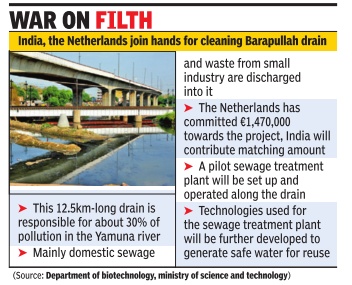
India, Holland tie up to clean Barapullah drain
Vishwa Mohan In what could be the first real proof that reviving the Yamuna in Delhi is possible, India and Netherlands have joined hands for cleaning of the Barapullah drain, responsible for nearly one-third of the waste that is dumped into the river which courses through the capital.Not just that. The focus will also be on generating safe water from sewage streams for reuse in areas like agriculture, relieving somewhat the water scarcity that dogs the city.
The idea is to make the project functional in three years. It is expected the project will reach its full capacity within five years when it will also be able to produce bio-gas and generate water for agriculture use. Under the project, a pilot sewage treatment plant (STP) will be set up and operated along the drain near Sarai Kale Khan with the support of the Dutch and the Indian consortium.
Scientists from IIT, Delhi will be part of the project.
The practical expertise generated through this pilot plant will focus on finding cost effective local solutions and adapt state-of-the-art Dutch technology to Indian conditions for the cleaning of the drain. The technologies will further be developed to gene rate safe water for reuse.“This is a very ambitious project and I am really hopeful that this will reap good results in a very short time“, said K Vijay Raghavan, secretary of the department of biotechnology (DBT), ministry of science and technology .
He said, “What we are experimenting with is to use a decentralised approach towards sewage treatment plants as well as implement new technologies“.
The project is part of a collaboration between the DBT and the Netherlands Organisation for Scientific Research and Technology Foundation.Scientists from both the countries already had a two-day workshop on the project here recently when they discussed the time-line and logistics.The estimated cost of the project is around Rs 21crore.
Focus on the Barapullah drain through such joint venture is, however, just a component of a larger plan to clean the river Yamuna by the government. There are 21 major waste water drains in the capital. Eighteen out of the 21empty their waste into the Yamuna while the remaining three join the AgraGurgaon canal.
Najafgarh and Shahadara are the other two other big drains which open into the Yamuna in Delhi where the river traverses a distance of about 46 kilometres.
Rejuvenation a success
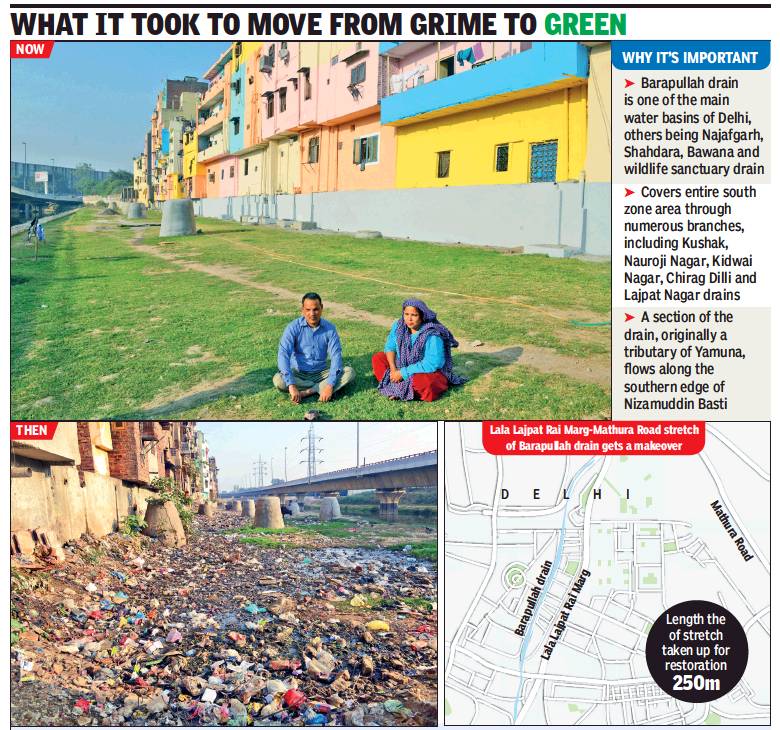
From: Richi Verma, From drain to sewer and back: The story of Barapullah rebirth, January 1, 2018: The Times of India
Four-Year Project Revitalises 250m Stretch Of Nullah, Surrounding Areas
Years of garbage, filth, slum waste and sewage dump made Barapullah Nullah one of the biggest eyesores of the capital. But after some painstaking work, the drain and its surrounding areas near Nizamuddin Basti have been rejuvenated through a massive four-year project that has involved not just cleaning and revitalising both sides of the drain, but also working with the community living close to it for a greener and cleaner environment.
The project is a part of the Nizamuddin Urban Renewal Initative, undertaken by Aga Khan Trust for Culture, with the support of the Norwegian ministry of foreign affairs. Officials said restoring this 250-metre stretch of the drain and its surrounding areas would rank as one of the most difficult tasks that the Nizamuddin Urban Renewal Initiative took up — in terms of the complexity of the task involved, number of team members involved and the arduous working conditions.
One of the main natural water basins of Delhi, the length of the Barapullah Nullah is more than 300km. The restoration work was taken up on the section between Lala Lajpat Rai Marg and Mathura Road. “This stretch, originally a tributary of the Yamuna, flows along the southern edge of Nizamuddin Basti. Over time, this historic nullah, which used to carry rainwater, became a grimy drain with waste water, solid waste and sewage. In the past few years, the Barapullah elevated road was built over portions of the nullah,” said an AKTC official.
Once the project was conceived, one of the challenges was to involve the community living along the nullah and discourage them from dumping garbage there. AKTC officials also targeted the facade of the houses along the nullah. “They were like an amorphous accumulation of unfinished blocks with most of the exterior unfinished — adding to the slum-like image of the basti,” said an official. The facade was given a facelift with a comprehensive repair and paint job. The next task was to complete the draining of the central channel, grading the existing earth levels into terraces and lining them with a retaining wall of dry stone masonry.
The toughest job, however, was to link the toilets in all the 144 households to the main trunk sewer rather than have them dumping human waste on the nullah banks. Delhi Jal Board relaid the sewerage line. Next, all households had to be convinced to contribute towards this process by paying a small portion of the cost, pledging not to dump garbage into the nullah and promising to give household garbage to waste collectors appointed by AKTC — another programme where waste is collected at the household level on a costsharing basis.
Many houses did not have dustbins and these were provided to them as an incentive. The land around the nullah had to be cleaned up and while plantation of trees is also planned, officials said, they have to ensure the saplings are eaten up by cattle.
The project, which started in 2014, involved coordinated efforts from multi-disciplinary teams. The engineering team worked on the nullah, connecting households to the sewer and on improving the facade of the houses; the horticulture team worked on the nullah sides, planting grass and trees; the community teams worked with households — convincing, encouraging, hand-holding and monitoring; even as the education team worked with children to spread awareness about cleanliness.
Encroachments
Banks, riverbed encroached upon/ 2002-17
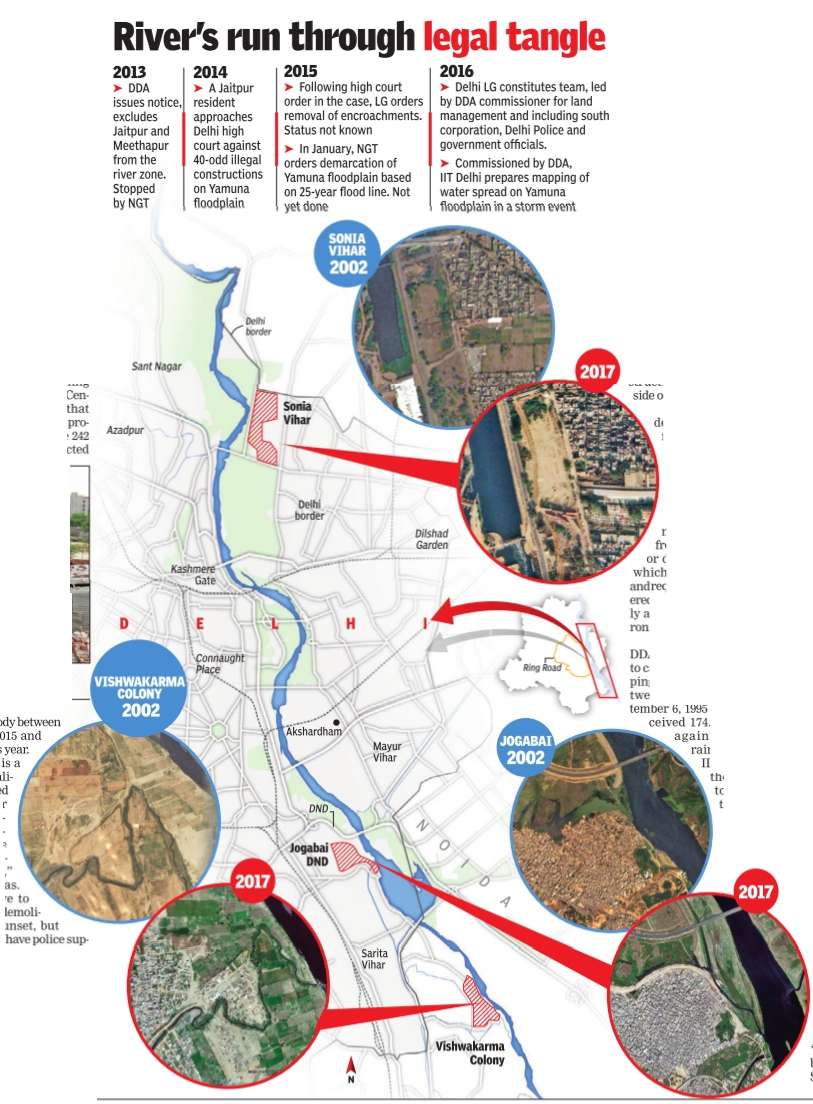
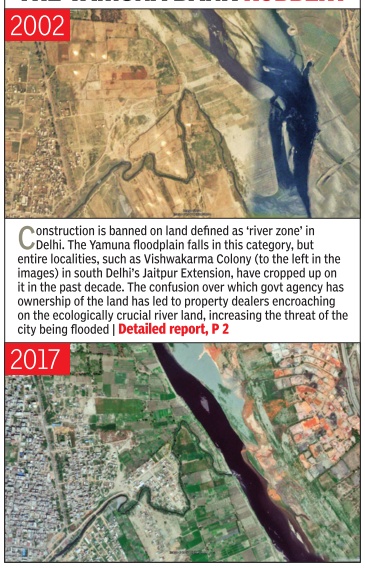
Vishwakarma Colony in south Delhi is the latest to encroach into the floodplain with property dealers taking advantage of opaque ownership rules. TOI traces the river's journey over the last 15 years to find Delhi's lifeline losing out to greed and indiscriminate urban growth
From the rooftop of Rukhsana's single storey house in Vishwakarma Col ony, you can see the Yamuna to the east. The river-facing location of the colony in south Delhi's Jaitpur Extension is one reason why Rukhsana's house should not even exist. Vishwakarma Colony falls in Delhi Development Authority's O, or river, zone, where no permanent constructions are permitted. The paradox does not end there. Despite being a no-construction zone, Vishwakarma Colony is actually expanding. As a property dealer confided, “The current “The current land price is Rs 10,000-15,000 per square yard. We sell land on power of attorney, so you will not get any other documents.“ He also claimed the cops have to be paid off.
The Jaitpur Extension colony is now among the concrete extensions into the ecologically important Yamuna floodplain that include the Commonwealth Games Village, Akshardham Mandir and Millennium Bus Depot. Hydrogeologists and scientists say Delhi is killing the river and rendering the capital vulnerable to flooding, but the official agencies tussle about who is responsible for which part of the floodplain.
The fear of floods, however, is no deterrent to encroachers.Rukhsana, who claimed to be living in Vishwakarma Colony for over a decade, and her peers have taken advantage of the lack of clarity over who owns the land in the floodplain. A spokesperson of DDA, which is the land-owning agency in the capital, told TOI, “The land in the floodplain at Jaitpur and Meethapur is private land, not development area. The South Delhi Municipal Corporation is responsible for preventing unauthorised construction.“
SDMC officials countered this by saying the primary responsibility of safeguarding the Yamuna floodplain lay with DDA.
They said that in the past year, SDMC demolished 168 properties and filed for prose cution of 186 other property owners in the Jaitpur area.
Just around 3 km from Jaitpur are Jamia Nagar and Abul Fazal Enclave, where too unauthorised construc ised construction is rampant. In the last two years, SDMC did book several property owners for unauthorised construction, but faltered in taking action. Explaining why , Mona Sreenivas, DC (Central Zone), SDMC, said that Delhi Police had provided protection for just 116 of the 242 demolition drives conducted by the civic body between January 1, 2015 and March 31 this year.
“Jaitpur is a “Jaitpur is a crowded locality and we need police to clear the neighbouring buildings before we demolish illegal structures,“ said Sreenivas.“We also have to complete the demolition before sunset, but we often don't have police support for this.“ A Delhi Police officer, while claiming security is always provided to corporation workers, retorted, “We constantly request civic bodies to inform us about demolitions a few days in advance, but we usually receive requests a few hours before a drive.“
Pollution in Yamuna
Increasing pollution in Yamuna
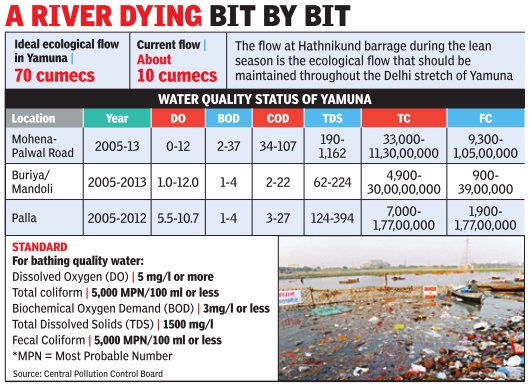
After 21 years of SC monitoring, Yamuna still stinks like a sewer
The Times of India, Jan 09 2015
Amit Anand Choudhary & Dhananjay Mahapatra
4 Lakh To 16 Crore Coliform In River Against Norm Of 5,000, CPCB Tells SC
Central Pollution Control Board told the Supreme Court why the Yamuna in its 22-km course through Delhi mostly stinks like a sewer drain as against the norm of 5,000 MPN coliform per 100 ml of water, Yamuna water in Delhi had between 4 lakh to 16 crore coliform per 100 ml. The norm of 5,000 MPN100 ml of water is the quality prescribed for `C' category of water, which is fit for drinking after treatment.But, on January 7, 2014, the total coliform in Yamuna water at Nizamuddin was 54000000 (5.4 crore) and at Kalindi Kunj it was 160000000 (16 crore). But, at Palla the river water is relatively clean. On January 7 last year the total coliform detected at Palla was 43,000.
After 21 years of intense monitoring of government efforts by the Supreme Court to clean the Yamuna, the CPCB, through advocate Vijay Panjwani, submitted to the court a detailed report on the state of pollution of river water at Pal la, Nizamuddin, Kalindi Kunj, Okhla and Madanpur Khadar in the 22-km stretch it flows through Delhi.
Despite the SC monitoring, Delhi appeared to be the biggest culprit in polluting the river. The water quality of Yamuna at Palla when it enters Delhi met the standard of “A“ grade water, which is fit for drinking without conventional treatment but after disinfection, in respect of pH level, dissolved oxygen, bio-chemical oxygen demand as well as coliform on most days except on five of the 12 testing days between November 19, 2013 and October 8, 2014.
But at the rest of the places through the city , the water did not even qualify to the standard of “C“ grade water and was declared unfit for even bathing. The CPCB also submitted the quality of water in 22 drains that joins Yamuna during its course through Delhi.
A year ago in December 2013, the Supreme Court had sought expert help from the Indian Institute of Technology (IIT) after being told by CPCB that despite Rs 5,000 crore spent for reducing pollution, the river was staring at a catastrophe as over 2,400 million litres of untreated sewage flows into it every day.
Since 1994, when the apex court took up monitoring of steps to reduce pollution in Yamuna, Uttar Pradesh has spent Rs 2,052 crore, Delhi government and its civic bodies Rs 2,387 crore and Haryana Rs 549 crore to clean the river, taking the total to Rs 4,988 crore.
A joint report by CPCB and DJB had informed the court a year ago that the situation would get worse as “waste water generation due to growth of urban population will be substantial and may be in the range of about 5,000 to 6,000 MLD respectively for the corresponding years 2021 and 2031“.
Rain not washing away toxins
Rain not washing away Yamuna toxins Jayashree Nandi The Times of India Dec 01 2014
New Delhi
Yamuna water is toxic, to say the least. But what is worse is that there seems to be a continuous discharge of industrial effluents into the Delhi stretches of Yamuna so that there is no improvement in postmonsoon months either when pollution is supposed to be far more diluted.
A recently concluded study by Toxics Link, an environmental NGO, found heavy metals like lead, chromium, arsenic and mercury to be several times the safe standard and, in some cases, even several hundred times the bathing water quality standard set by Central Pollution Control Board in preand post-monsoon months.
A team of researchers collected water samples from seven locations starting with Jagatpur village where the water appears to be marginally cleaner. The researchers travelled by boat to be able to collect water in bottles and buckets from near Najafgarh drain, Wazirabad, Majnu Ka Tila, near Vidhan Sabha drain, ISBT and Yamuna Bazar. The water samples were analysed for the most toxic heavy metals. Chromium levels were the highest with a maximum concentration of about 796.99 parts per million when the standard is 0.5ppm. The maximum level for lead was 55.7ppm when the standard is 0.1ppm.
“We couldn't find a uniform trend in preand postmonsoon levels which show that industries are constantly discharging these heavy metals leading to high toxicity levels throughout. We are also assessing whether the high chromium levels are due to tanneries discharging untreated effluents. But it's clear that a lot of industrial waste is polluting Yamuna,“ said Prashant Rajankar, programme coordinator, Toxics Link. High chromium levels are often linked to skin rashes, ulcers, weakening of the immune system, kidney and liver damage and many other health impacts.
The study was also used as an introduction for the recently concluded India Rivers Week where about 125 academics, scientists, activists from all states thrashed out the definition of a “healthy river“ and what is ailing Indian rivers. The reason for organizing such a conference is also the current government's agenda of interlinking rivers.
The 125 experts will work in four groups to arrive at a consensus on certain crucial issues related to rivers and controversial or `environmentally unsound' projects like interlinking or rivers, massive hydropower projects, dams and others. At the end of four days, experts will prepare an India rivers charter articulating the vision for saving rivers.
At IRW, experts also drew attention to a recent appraisal by Yamuna Jiye Abhiyan that has found there is no river in any of the top 50 cities (based on population) in India that is not sick or dying with river Yamuna in DelhiMathura-Agra and Ganga in Kanpur-Varanasi-Patna leading the list.
Pollution is irreversible
The Times of India, Feb 08 2015
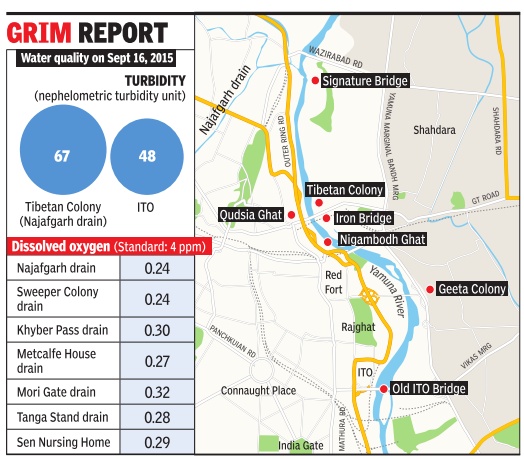
Yamuna pollution can't be reversed: Water commission
Arvind Chauhan
The Yamuna, by the time it flows through Agra, has nearly 50 times more biochemical oxygen demand (BOD) than the permissible limit. The Central Water Commission (CWC) has declared that the river water at Agra is safe neither for irrigation nor for domestic use.Water in the river, now polluted beyond repair, an official said, is also contaminating ground water.
BOD is the amount of dissolved oxygen needed by aerobic biological organisms to break down orga nic material, in a given time and at a certain temperature. Once BOD increases beyond a certain limit, it becomes a pollutant, leading to the growth of harmful bacteria.
BOD forms when the equilibrium of chemical compounds and solid waste is disturbed in a water body .
A CWC official said, “This contamination level is irreversible. Water is unusable, both for irrigation and drinking. In fact, polluted water from the Yamuna is also partially responsible for the contamination of ground water in Agra.
Chhath (and other) pujas
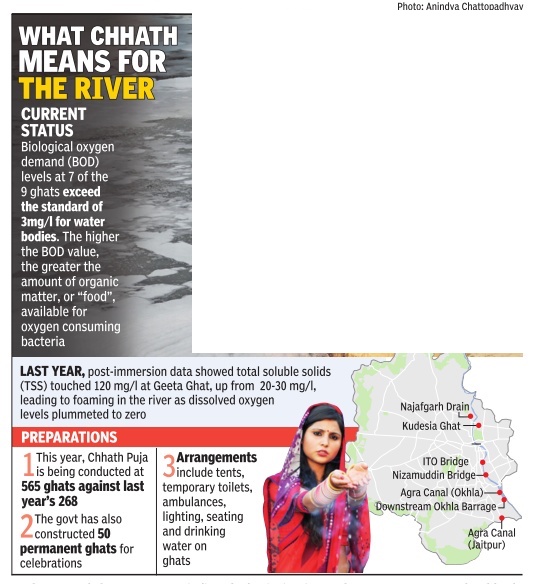
From: Jasjeev Gandhiok, Already polluted river braces for yet another onslaught, October 26, 2017: The Times of India
City ghats are all decked up for chhath puja: while extensive preparations have been made to ensure that devotees face no hardships, environmentalists are having sleepless nights over what it could mean for the already fragile river.
Immersions during Ganesh Chaturthi and Durga Puja had led to pollution levels soaring at Yamuna. The National Green Tribunal had taken civic bodies to task over semi-dissolved idols and puja material being strewn all over the banks.
As devotees prepare to enter the Yamuna to offer prayers to the Sun God, similar fears are being expressed, even as experts say that foam in the river already testifies to the poor quality of water post-immersion last month.The Delhi government has declared a holiday on the final day of the three-day festival, which sees devotees entering the water and offering `Arghya' to the setting sun.
A Delhi Pollution Control Committee official told TOI that special steps have been taken to monitor pollution levels in the river. “We have barricaded the river and arrangements have been made on the banks for the puja. The ghats will be cleaned immediately after the puja is over,“ the official said.
A report released by DPCC last year had shown an increase in biological oxygen demand (BOD) levels up to 30 mgl at several ghats, even as dissolved oxygen levels plummeted to zero. The standard BOD level for water bodies is 3mgl. DO should be 4 mgl, or higher. Yamuna's water quality is currently in the `E' category, which makes it fit only for irrigation and industrial usage.
Satish Sinha, associate director of NGO Toxics Link, said: “As it is, the water in Yamuna is very polluted. Lead and heavy metals present in the river can prove harmful, so exposure should be reduced.“
This year, the government has earmarked 565 ghats for chhath puja against 268 last year. It has also constructed 50 permanent ghats for the celebrations.
Delhi, Panipat, Sonepat are the main polluters
Jayashree Nandi, Delhi equally to blame for dirty Yamuna, February 28, 2018: The Times of India
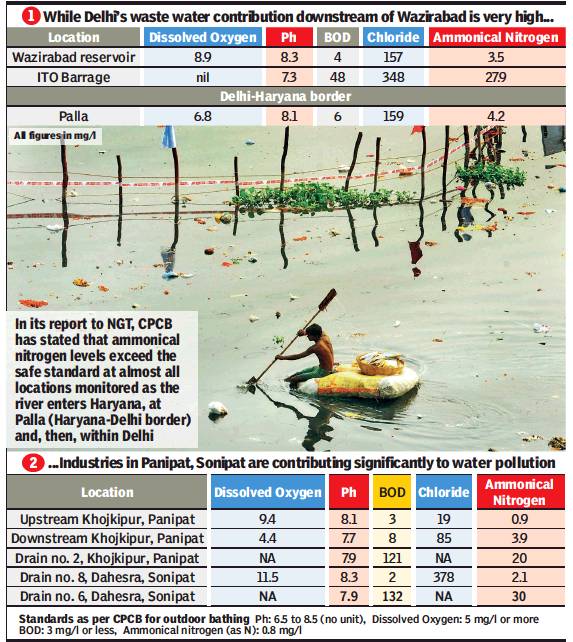
From: Jayashree Nandi, Delhi equally to blame for dirty Yamuna, February 28, 2018: The Times of India
A Central Pollution Control Board report submitted to the National Green Tribunal has found the levels of ammoniacal nitrogen (as N) exceeds the safe standard at almost all locations monitored as the river passes through Haryana, Palla (Haryana-Delhi border) and then within the Delhi stretch.
Ammonaical nitrogen is basically a measure for ammonia, a pollutant often found in waste water, fertiliser run off or industrial effluents. It is known to reduce the effectiveness of water treatment technologies.
The report submitted by CPCB on Tuesday indicates that the ammoniacal nitrogen level upstream of Khojkipur in Panipat is 0.9 mg/l, while the safe standard is 0.8 mg/l. As the river passes through other drains in Haryana, levels go up significantly, testing at 30 mg/l at drain no. 6, Dahesra, Sonepat. At Palla border it improves to 4.2 mg/l, still above the safe limit even after treatment for drinking water supply to Delhi. At ITO barrage with Delhi’s untreated waste water also adding to Yamuna water, ammoniacal nitrogen level rises to 27.9 mg/l.
The report which has test results from samples collected on February 23, 2018, shows that industries in Panipat and Sonepat may be contributing significantly to Yamuna water pollution but even Delhi’s waste water contribution downstream of Wazirabad is very high and may be impacting water used from Agra canal for irrigation purposes.
Overall, the report indicates the water is at its best quality before drains in Panipat and Sonepat start polluting it.
Dissolved oxygen (DO) levels were also found to be nil at ITO barrage, indicating that the river in Delhi is nearly dead. DO is necessary for the survival of many forms of life including fish, invertebrates and aquatic plants. The Ph levels are complying with standards at all locations. The Biochemical Oxygen Demand (BOD) (the amount of DO needed by microorganisms in various biological processes) at most locations, even in Haryana, exceeds the standard.
“The primary cause for high ammonia levels is industries in Panipat and Sonepat discharging effluents and polluting water bodies. It’s a recurring problem. Water with high ammonia is not potable, treatment processes cannot also bring to acceptable limits. However, when Delhi says Haryana is not taking care of treating the water that’s coming to Delhi, it should also look at what the capital is releasing downstream,” said Manoj Misra of Yamuna Jiye Abhiyan.
According to WHO, high ammonia levels are an important indicator of faecal pollution. “Taste and odour problems as well as decreased efficiency in disinfection are to be expected if drinking water with more than 0.2 mg of ammonia per litre is chlorinated.”
Shashank Shekhar, assistant professor in the department of Geology, Delhi University, said that when water with high levels of ammonia is treated in a plant which uses chlorination to treat water, there is a chemical reaction which forms chloramine. Chloramine has various health impacts, which is why water polluted with ammonia cannot go through chlorination.
According to Chloramine-.org , people with liver or kidney disease and those with hereditary urea cycle disorders are at increased risk for ammonia toxicity from the consumption of chloraminated water. Chloramine cannot kill the pathogens in the water as well as chlorine. As a result, people with suppressed immune systems must have their water boiled over 10 minutes before use to kill pathogens, or they risk becoming ill.
The Pollutants
2018: foam after idol immersion
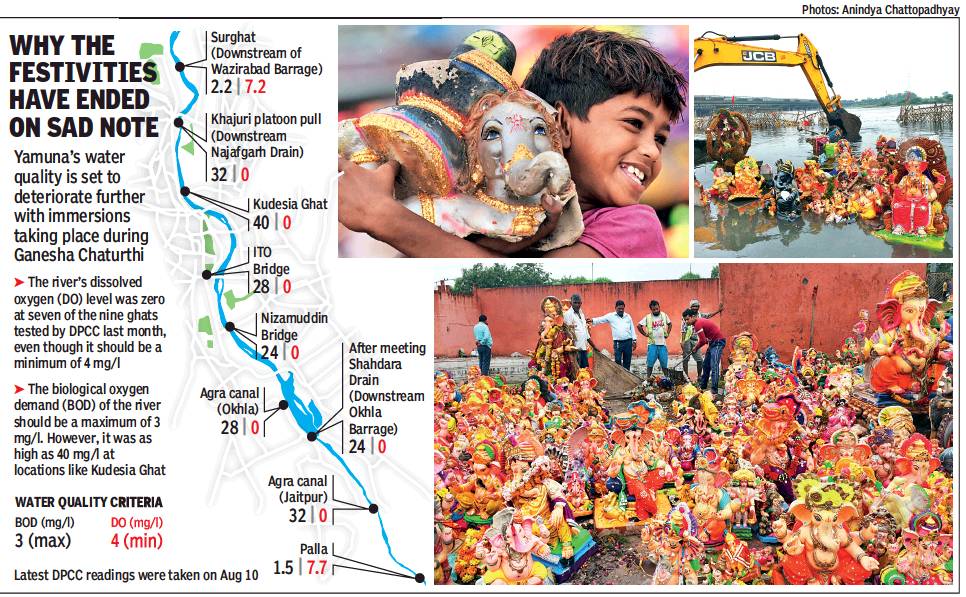
The likely impact of the idol immersions of Sept 2018.
From: Jasjeev Gandhiok, Yamuna foams at mouth after idol immersions, September 25, 2018: The Times of India
The temporary gains from monsoon seem to have already been lost: the Yamuna, which was visibly cleaner due to rain, once again wore a foamy look on Monday after thousands of idols were immersed for Ganesh Chaturthi.
Many such idols could be seen floating on the ghats — some half-dissolved, others completely intact — perhaps indicative of the Plaster of Paris (PoP) that is used to make them. Decoration material, flowers and pieces of cloth provided a grim reminder of how NGT orders continued to be blatantly flouted.
Pollution levels in the river were already extremely high, according to a test conducted by Delhi Pollution Control Committee (DPCC) on August 8. It was found that dissolved oxygen — required to sustain aquatic life — was 0 in seven of the nine ghats. DO levels should be 4 mg/l or above. Similarly, the report found Biological Oxygen Demand (BOD) to be as high as 40 mg/l at places like Kudesia Ghat against a prescribed standard of 3 mg/l or below.
DPCC officials said the immersion process, especially the usage of PoP, was likely to push these levels further up. “We have started the testing process and will compare pre- and post-immersion samples. These will also be compared with last year’s readings,” an official said.
An SDMC official claimed that while immersions were lower this year, the preparation was also a lot better. “We did not allow PoP idols to be immersed and they were kept on the ghats from where they were collected on Monday,” the official said.
A corporation worker, who didn’t want to be named, said: “Water levels have been extremely low at some locations and, as such, idols could only be half-submerged. Decoration pieces were recovered in kilos from the river.”
The use of PoP idols was banned by NGT in 2015 as they don’t dissolve easily in the river. The tribunal had later issued instructions to remove all decorations before the idols were immersed.
Experts said with Durga Puja round the corner, better preparations would be required to avoid a repeat of the situation. “Idols containing toxic dyes are immersed each year and the rules are rarely followed. Better implementation of the NGT order is required on the ground,” Manoj Mishra, convener of the Yamuna Jiye Abhiyaan, said.
Before, during and after the immersion
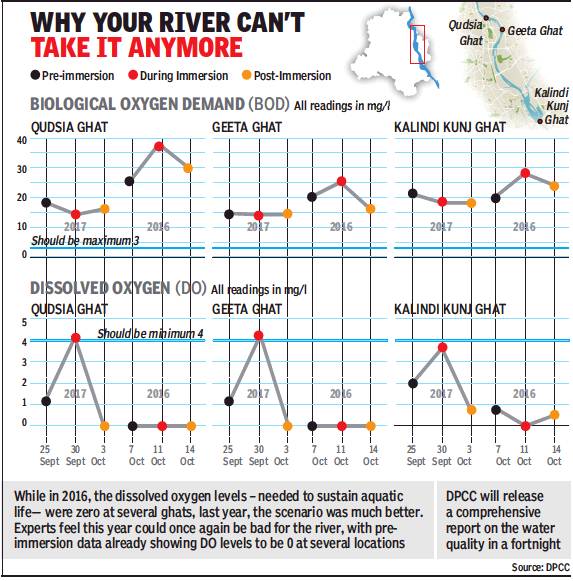
From: Jasjeev Gandhiok, DPCC to submit Yamuna report in 15 days, October 20, 2018: The Times of India
See graphic:
The state of the Yamuna- before, during and after the immersion, 2018
The situation after Dusshera/ 2018
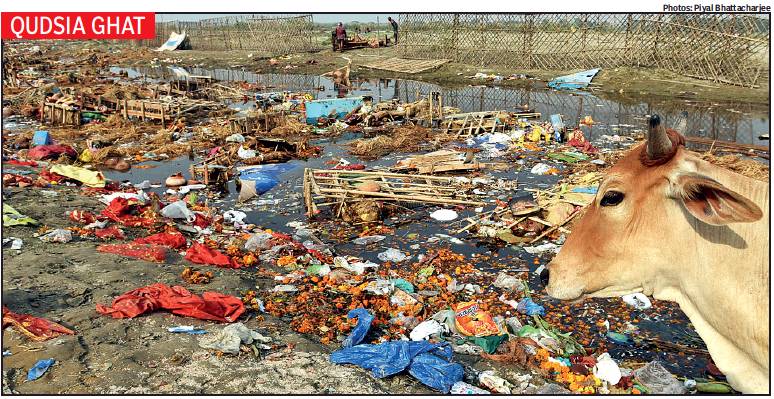
From: Jasjeev Gandhiok, After Friday fanfare, Yamuna resembles decaying waste field, October 21, 2018: The Times of India
Contract Workers Will Take A Week To Clean Remnants Of Idols, Adornments
At Qudsia Ghat, Monu Kumar wades into the Yamuna, scrounging for anything useful in the ghostly debris in the water. The scene is eerily different from the chaos and noise of Friday when hundreds of bright-hued idols reached there amid much fanfare for immersion. As Kumar pokes around, he comes across an intact Durga idol. It is probably made of plaster of Paris because even 24 hours of submergence in water has not broken it down.
The shallow stretch looks like a typhoon devastated shore village. On the ghat are large mounds of decaying flowers and muddied adornments that had been pulled off the idols before immersion. Emerging out of the water is an ugly mess of straw, sticks and wood — the remnants of the idols. Among them, disconcertingly, a limb or a beauteous eye of Durga still refuses to yield to the water’s dissolving power.
“Only around 10% of the idols this year were made of plaster of Paris since rules no longer allow the use of PoP,” says Jeetu Parchar, a contractor appointed by the North Delhi Municipal Corporation to clear the ghat after the Durga Puja festivities. “Our bigger burden is retrieving the non-soluble decorations that embellished the idols. The guidelines are that these need to be removed before placing the idol in the river, but we come across all sorts of materials, even glass, in the water.”
Ideally, only the wooden scaffolding that held the idols erect should remain in the water. Corporation officials say these are reusable and are taken to the corporation stores. Everything else is collected and sent directly to a landfill. “The task of sifting through the waste is tedious. The workers scavenge whatever is useful or can be used, but most of the muck is piled up and sent to Ghazipur,” said Parchar.
The workers are paid Rs 400 a day to clean the Yamuna, a task that lasts almost a week. “We lift out 50 to 60 idols each day, and it takes seven-eight men to take these out of the river,” said Ashu Kumar at Geeta Ghat. “The larger idols are almost impossible to drag out and we have to resort to cranes. We do end up getting a decent amount of money.”
As the contracted workers go about their work at Geeta Ghat, a group of children huddle together a few metres away. They are discussing their finds. As here, the immersion sites at Hathi Ghat, Qudsia, Kalindi Kunj, Shyam Ghat, Sur Ghat, Yamuna Ghat, DND Flyway and Mayur Vihar Extension Ghat provide some pickings for scavengers in the form of baubles and trinkets to sell in the market. They also come across coins, sometimes even damp currency notes.
Monu Kumar, employed to clean the river, admits he himself has not had much ‘luck’ in this department. “Most items of any value are taken by scavengers on the immersion day itself. Those who don’t get anything return at night, so you rarely find anything of worth the day after,” reasons the 25-year-old.
There was one more chance for ragpickers on Saturday, a day after Vijayadashmi, when some puja committees arrived to consign their idols to the river. “We avoided Friday because we knew it would be too crowded,” explains Ramesh Verma, who has come from Sultanpuri. “Usually, we immerse our idol a day later when the ghats are freer and we can go to the deeper parts of the river to ensure proper submergence. The portions demarcated at the ghats are always shallow, and it is an insult to Goddess Durga to leave her wallowing half out of water.”
Floods in Yamuna
1980-2014: Yamuna floodplains
The Times of India, March 28, 2016
Jayashree Nandi
With land regulation along the Yamuna remaining lax, there is danger ahead. Not only is the river being constricted, but the floodplains itself has narrowed drastically between 1980 and 2014 - leading to fears that there can be massive flooding in Delhi in the coming years.
The signs are already there. In recent monsoon seasons, many areas in southeast Delhi have seen basements of buildings getting submerged under water.
A recent study by IIT Kanpur and Delhi University published maps that showed how the Yamuna's floodplains has narrowed drastically in three and half decades. The fear is that in the absence of an unambiguous policy to protect the floodplains, more river zone land will be diverted for construction, compounding the problem.
"The topographic and satellite maps of Delhi from 1980 to 2014 indicate temporal variation in channel geometry and the position of river Yamuna ... it is observable that after 1980 the remaining floodplain areas were rapidly occupied by settlements, civic structures, roads, bridges, flyovers, playgrounds and metro stations," said a study published in 2014 in the International Journal of Research in Engineering and Technology. It concludes that identifying and "delineating" features such as older and active floodplains, paleo-channels and meandering channels are essential for hydrogeological evaluation.
Afzal Khan, assistant professor at Shimla University and co-author of the study, said that the considerable impact of the encroachment on the Yamuna's channels has to be studied more thoroughly. The narrowing of the riverine plains has taken place despite the regulations provided for under Delhi Development Authority's "O" zone that disallow any permanent constructions and despite the Central Ground Water Authority having declared the Yamuna floodplains a "recharge zone". Shashi Shekhar, head of the National Green Tribunal's Principal Committee on Yamuna and secretary of the ministry of water resources, said the panel was aware of the river's constriction, but explained there were no laws at the moment to protect against encroachments. "The land belongs to three agencies - DDA, Delhi irrigation department and UP irrigation department - which adds to the problem," said Shekhar.
The flow in the Yamuna ranges from 3,500 cusecs between December and February to as much as 8 lakh cusecs for a few days after the monsoon rains. According to experts, the much awaited notification of the River Regulation Zone drafted in 2002 could help regulate or prohibit activities on specified stretches of the river on both sides of the natural levee. The draft notification did go to the law ministry, but hasn't moved forward after it came back to the ministry of environment and forests.
The National Water Mission under the National Action Plan on Climate Change has also recommended zoning og floodplains to avoid climate change induced disasters. "We know that Germany and England and other countries have started to gradually remove dykes and embankments to be better prepared for floods," said Shekhar.
Contradicting the common belief that the Yamuna floodplains is fallow land that is much required by land-starved Delhi, Shashank Shekhar, professor at the department of earth sciences in Delhi University, said, "That is not so - the floodplains is the most important water reservoir for the city in times of crisis." He is worried about the encroachments that are visible in the bund road along Jaitpur and Sarai Kale Khan.
He believed that the sudden flooding of basements in areas such as Okhla, Sukhdev Vihar and Lakshmi Nagar in recent years have been caused by "lack in connectivity of the floodplains to its catchment or its basin due of encroachments".
The Yamuna: The highest flood levels recorded
The Yamuna, which has been reduced to being just a drain, transforms during the rains into a raging, menacing river
1978 | 5 Sept 207.49m
The Yamuna touched 207.49m on September 5 after 7 lakh cusec water was released upstream. Large parts of west, north and east Delhi, including Shalimar Bagh, Model Town and Mukherjee Nagar, were under 4-5 feet of water. It remains Delhi’s worst flood to date
1988 | 21 Sept 206.92 m
Continuous torrential rain in the hills from September 21 raised the Yamuna’s level to 206.92m at the Old Railway Bridge. Many areas in east and north Delhi, including Mukherjee Nagar, Geeta Colony, Yamuna Bazaar and Red Fort were affected
1995 | Sept 206.93 m
In Sept, river touched 206.93m. While release from Tajewala was massive, Delhi didn't let out water from Okhla barrage fast enough. Around 15,000 families lived in temporary shelters on main road for two months
2010 | Sept 207.11 m
Towards the end of September, the Yamuna rose to 207.11m and stayed at that level for eight hours. Areas like Kashmere Gate, Batla House, parts of Ring Road, Jaitpur and Majnu Ka Tila were flooded. Back flow from sewers submerged hundreds of houses in low areas
Do floods help the Yamuna?
2013/06/22
Swell in Yamuna kills the stink
If you thought the Delhi stretch of Yamuna had long become a sewage pool, visit the river now. Flooded to the brim, it is reminiscent of what Yamuna may have originally looked like. The flood may have played havoc by displacing communities but it has also managed to dilute the polluted water and enliven a dead river.
Towards Okhla (downstream) the river water usually has a biochemical oxygen demand of 40 to 50 mg/l but since June 15, the BOD measured less than10 mg/l according to Central Pollution Control Board.
BOD is an important determinant to show how polluted the river water is. It is a measure of the quantity of oxygen used by microorganisms in the oxidation of organic matter. The acceptable limit of BOD is 3 mg/l.
“The pollutants have been washed away but the water is very turbid because of the debris that has come with the floodwater and runoff from agricultural fields. Even after the water level recedes, there will still be surplus water and we expect that pollution levels will be low for about two months,” said a senior officer from CPCB.
The flooding will also have an impact on the groundwater say scientists. Saumitra Mukherjee, professor of geology and remote sensing, School of Environmental Sciences, Jawaharlal Nehru University, says that there are lots of negative effects of flooding but one of the positive impact is the improvement in soil quality. “The flood brings with it fine silt, clay and sand. These and the sediment formed from them are usually fertile and can be beneficial for agricultural purposes. The floodwater also helps recharge underground aquifers,” he says.
However, he warns that the floodwater loaded with fecal matter can contaminate both the surface water and groundwater. “There has to be intensive monitoring of the water quality to check if it can cause contamination. When the floodwater starts receding there is a high chance of an epidemic and spread of bacterial infection among communities living by the river,” he adds.
The flooding also impacts aquatic life. The dead river may now have enough water to create the environmental conditions for spawning of certain species of fish.
“Floods are very important for Yamuna in Delhi. Earlier we had a lot of wetlands but development has eaten in to those. Usually during floods when the floodwater recedes, these pools or wetlands are recharged. Even our floodplains have been encroached upon. We need forests and grasslands by the river to retain and use the floodwater. We need a river front forest ecosystem,” adds Faiyaz A Khudsar, scientist at Yamuna Biodiversity Park
Floods rejuvenate river
Soil and water quality in Yamuna likely to remain slightly better for a couple of months from now Contaminated floodwater can also pollute groundwater. There are high chances of an epidemic as water recedes
Floodwater loaded with fine silt, clay and sand is likely to make the Yamuna soil fertile and will be benefi cial for agriculture
Floodwater will help recharge underground aquifers
It will rejuvenate wetlands near Yamuna
Flooding can induce breeding or spawning in some fish species in Yamuna
Flooding has already diluted polluted water near Okhla
Flooding can be alarming for some species like snakes and insects, which have started coming out of the burrows
River corridor vegetation and agriculture in floodplains likely to improve after fl oodwater recedes
2018: highest in 5 years
Yamuna breaches 206-metre mark, highest level in 5 years, August 1, 2018: The Times of India
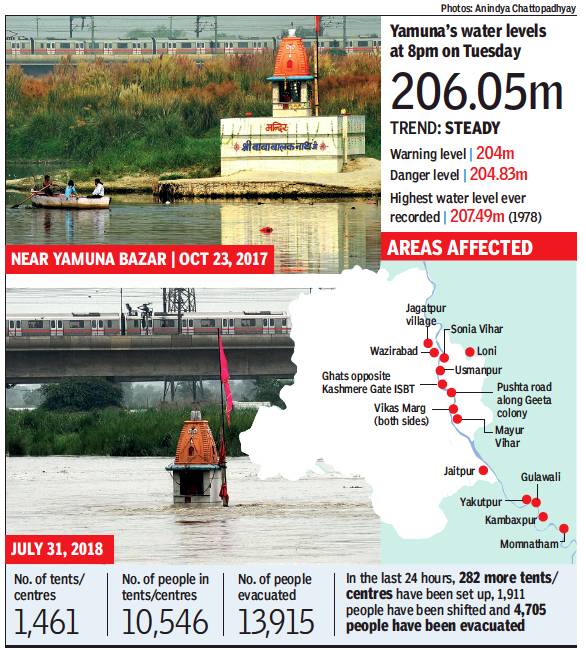
From: Yamuna breaches 206-metre mark, highest level in 5 years, August 1, 2018: The Times of India
RELIEF WORK ON; TRAIN MOVEMENT DISRUPTED ON LOHA PUL
For the fourth consecutive day, the water levels in the Yamuna continued to rise as it crossed the 206-metre mark morning — the highest in the past five years.
At 8pm, the water level was 206.05 metres as another 28,126 cusecs of water was released from Hathnikund Barrage, taking the total release to 5 lakh cusecs in four days. As several low-lying areas remain impacted, Central Water Commission classified the water levels as ‘steady’.
So far, 10,564 people have been evacuated by the Delhi government and around 1,461 tents have been set up.
Emergency services are also being provided wherever required, said officials. “The water levels reached further inwards on Tuesday. Meals are being provided three times a day and we have medical staff on the standby along with disaster management teams,” said K Mahesh, DM (east and Shahdara).
A number of ghats along Kashmere Gate ISBT got submerged with sandbags being used to stop the flow towards Ring Road since Monday. “We placed sandbags on Monday but the water level has almost reached the road in some parts. More sandbags will be used if required,” said an official. Delhi’s revenue, flood and irrigation minister, Kailash Gahlot, has taken stock of the situation after visiting some of the affected areas. Meanwhile, Old Yamuna Bridge, popularly known as Loha Pul, remained shut with the traffic being diverted towards Geeta Colony, the police said. The railway operations on it, too, were stopped in the early hours, and two passenger trains were cancelled, 19 short-terminated and 17 diverted.
The highest ever water level recorded at Old Yamuna Bridge was 207.49 metres in 1978, while it touched 207.32 metres in 2013 — the last time Delhi saw such a situation.
The Ghaziabad administration has also sounded an alert after the river water entered the floodplains in Loni, affecting agricultural activities.
Loni SDM Satendra Singh said, “Seven-eight labourers, who were keeping a watch on rose cultivation in the floodplains, have been shifted to safe places. The inhabited areas are on the opposite side of the Alipur dam in Loni, and they are safe at present. The water level receded by 10cm by the evening.” The areas adjoining Hindon river got flooded after water back-flowed into the river and breached the walls made by farmers to protect their land, said Neeraj Kumar Lamba, executive officer, irrigation department.
Gopal Rai, a resident of Nagla who shifted with his family to Panchayat Bhawan, said, “The current in the Hindon is quite strong and there are chances that water may reach our home. As a safety measure, we have shifted here. Two-three other families have also taken shelter at Panchayat Bhawan.”
In Noida, the Yamuna water entered farmlands along the 29km-long embankment on the floodplains on Tuesday. The district administration said they still didn’t need to start any relief work. However, the rising level of water has destroyed crops on hundreds of acres on the floodplains. Ali Hasan, a resident of Gulawti village, said, “I have 20 acres along the floodplains, and the crops have been ruined.”
Government efforts
Riverfront planning: 1913-2000
Feb 11 2015
Jayashree Nandi
Riverfront planners caught in time warp
Govt trying to urbanize Yamuna since 1913: Scientists
Delhi had planned for a riverfront for Yamuna as early as 1913 to give the new capital an aesthetic promenade from Wazirabad in the north to Indrapat (Purana Qila and its surroundings) in the south.Hundred years on, the central government continues to idealize urban riverfronts like that of the Sabarmati and has been floating proposals to make Yamuna an urban infrastructure component such as dredging it to make it navigable. Awadhendra Sharan, associate professor at Centre for the Study of Developing Societies, whose research paper on Yamuna was published in Elsevier's journal of City , Culture and Society, traces how various authorities at different times in history tried to develop the river and the riverfront.
Around 1956, the Town Planning Organization suggested development of a riverfront for recreational activities with playgrounds, swimming pools, and fishing and bathing areas. “It drew attention to the possibility of taming the river by building a dam,“ writes Sharan.
Cultivation of melons on the banks in summer and fishing were common in Okhla. Floods were an annual phenomenon but there was ample land for free flow of river during the monsoon months. A new phase of urbanizing the river began after Independence in 1955-56 leading to floods becoming a health issue with w aste water discharge points near the river affecting quality of drinking water. In 1990, DDA too planned several urban projects to integrate the city and river.
Over the past two decades, Yamuna became extremely polluted and ceased to be a peren nial river. This is when the gov ernment started blaming squatters in illegal colonies along Yamuna for the pollution and began pushing “technologi cal solutions“. One of the major changes in approach is marked by the high court nod to the Com monwealth Games Village. Sha ran recollects in his paper how there were discrepancies in var ious technical reports submit ted to the court on the impact of Games Village which led to the court deciding that the area for it was not on the floodplains.
Another high court decision in March 2003 led to removal of the Yamuna Pushta slum clus ter. But various studies and ex perts say this will not help ad dress pollution.Sharan suggests the “precautionary principle“ should have been applied before such irreversible changes--like building Akshardham and the Games Village--were made. “I have tried to argue from all the historical evidence that's availa ble that we should leave the river as it is and not convert it into a re al estate operation. That makes more economic and ecological sense,“ Sharan says.
Yamuna riverfront development plan
see the graphics on this page including 'Yamuna riverfront development plan, 2001-16' and 'Yamuna riverfront development plan, DDA’s proposal of 2016'
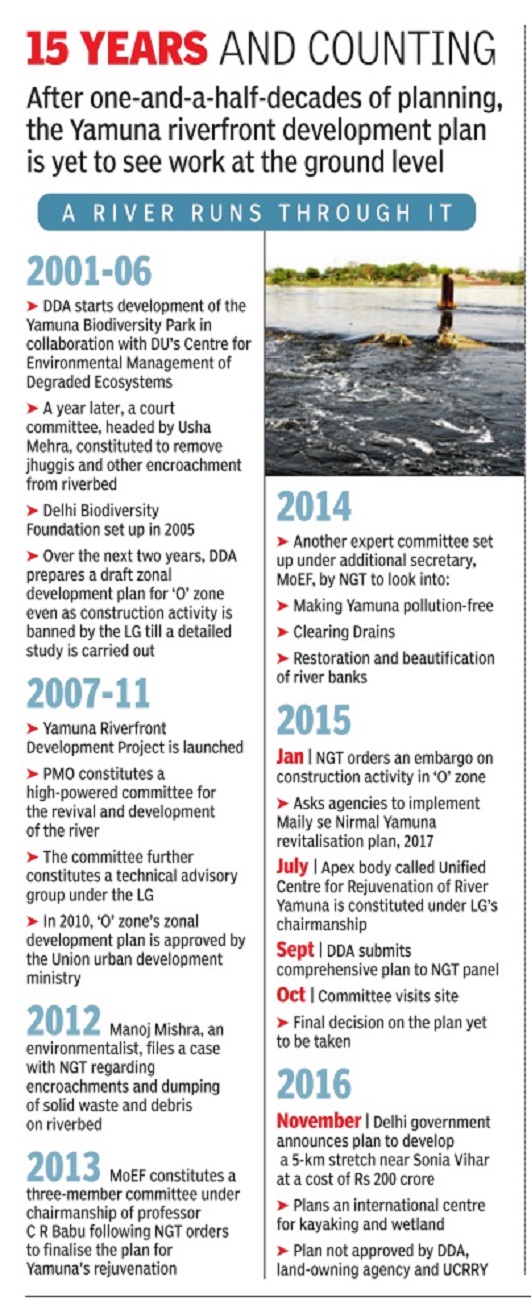
The Times of India
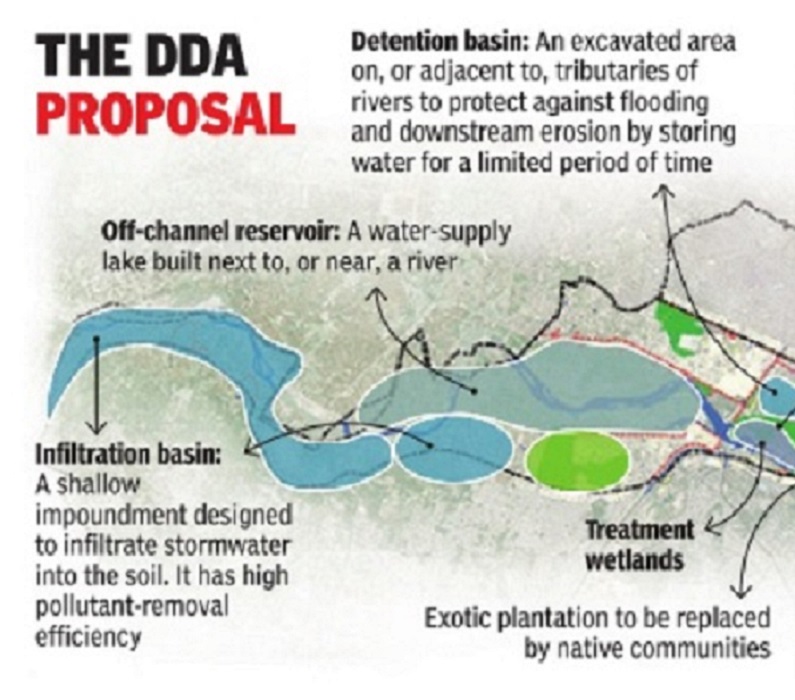
The Times of India
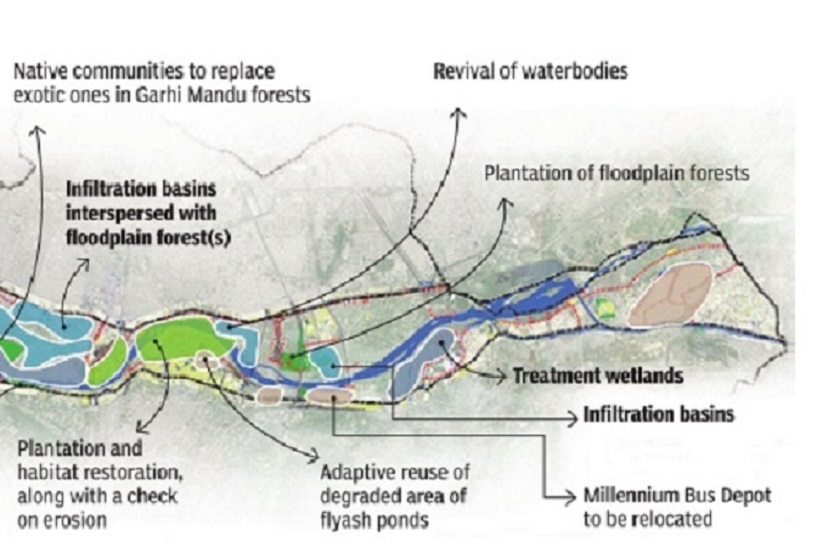
The Times of India
